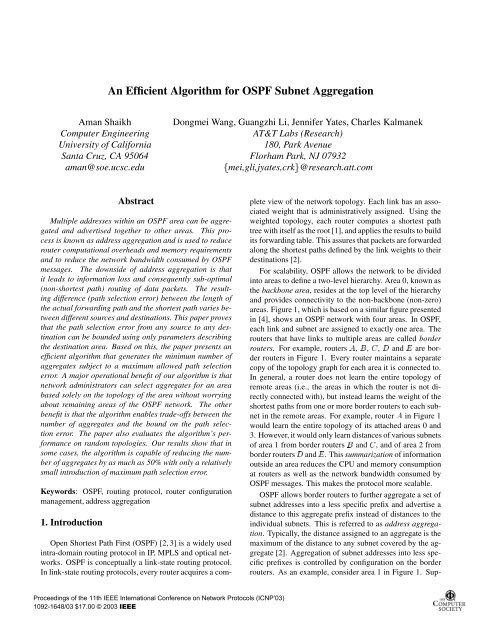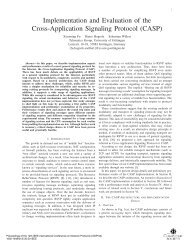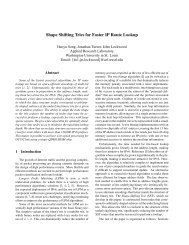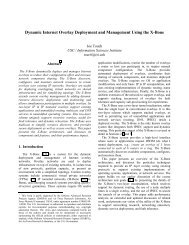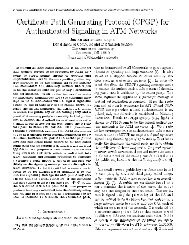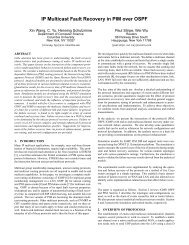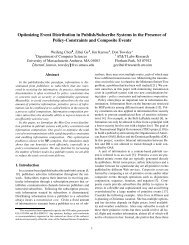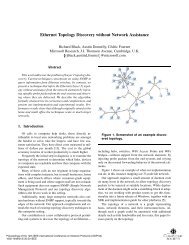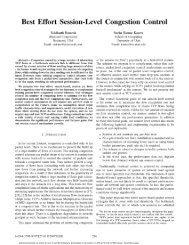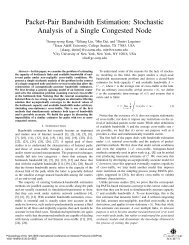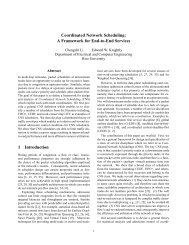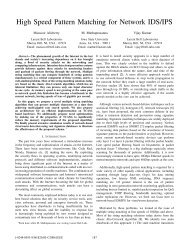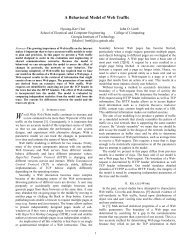An Efficient Algorithm for OSPF Subnet Aggregation - ICNP
An Efficient Algorithm for OSPF Subnet Aggregation - ICNP
An Efficient Algorithm for OSPF Subnet Aggregation - ICNP
Create successful ePaper yourself
Turn your PDF publications into a flip-book with our unique Google optimized e-Paper software.
<strong>An</strong> <strong>Efficient</strong> <strong>Algorithm</strong> <strong>for</strong> <strong>OSPF</strong> <strong>Subnet</strong> <strong>Aggregation</strong><br />
Aman Shaikh<br />
Computer Engineering<br />
University of Cali<strong>for</strong>nia<br />
Santa Cruz, CA 95064<br />
aman@soe.ucsc.edu<br />
Dongmei Wang, Guangzhi Li, Jennifer Yates, Charles Kalmanek<br />
AT&T Labs (Research)<br />
180, Park Avenue<br />
Florham Park, NJ 07932<br />
fmei,gli,jyates,crkg@research.att.com<br />
Abstract<br />
Multiple addresses within an <strong>OSPF</strong> area can be aggregated<br />
and advertised together to other areas. This process<br />
is known as address aggregation and is used to reduce<br />
router computational overheads and memory requirements<br />
and to reduce the network bandwidth consumed by <strong>OSPF</strong><br />
messages. The downside of address aggregation is that<br />
it leads to in<strong>for</strong>mation loss and consequently sub-optimal<br />
(non-shortest path) routing of data packets. The resulting<br />
difference (path selection error) between the length of<br />
the actual <strong>for</strong>warding path and the shortest path varies between<br />
different sources and destinations. This paper proves<br />
that the path selection error from any source to any destination<br />
can be bounded using only parameters describing<br />
the destination area. Based on this, the paper presents an<br />
efficient algorithm that generates the minimum number of<br />
aggregates subject to a maximum allowed path selection<br />
error. A major operational benefit of our algorithm is that<br />
network administrators can select aggregates <strong>for</strong> an area<br />
based solely on the topology of the area without worrying<br />
about remaining areas of the <strong>OSPF</strong> network. The other<br />
benefit is that the algorithm enables trade-offs between the<br />
number of aggregates and the bound on the path selection<br />
error. The paper also evaluates the algorithm’s per<strong>for</strong>mance<br />
on random topologies. Our results show that in<br />
some cases, the algorithm is capable of reducing the number<br />
of aggregates by as much as 50% with only a relatively<br />
small introduction of maximum path selection error.<br />
Keywords: <strong>OSPF</strong>, routing protocol, router configuration<br />
management, address aggregation<br />
1. Introduction<br />
Open Shortest Path First (<strong>OSPF</strong>) [2, 3] is a widely used<br />
intra-domain routing protocol in IP, MPLS and optical networks.<br />
<strong>OSPF</strong> is conceptually a link-state routing protocol.<br />
In link-state routing protocols, every router acquires a complete<br />
view of the network topology. Each link has an associated<br />
weight that is administratively assigned. Using the<br />
weighted topology, each router computes a shortest path<br />
tree with itself as the root [1], and applies the results to build<br />
its <strong>for</strong>warding table. This assures that packets are <strong>for</strong>warded<br />
along the shortest paths defined by the link weights to their<br />
destinations [2].<br />
For scalability, <strong>OSPF</strong> allows the network to be divided<br />
into areas to define a two-level hierarchy. Area 0, known as<br />
the backbone area, resides at the top level of the hierarchy<br />
and provides connectivity to the non-backbone (non-zero)<br />
areas. Figure 1, which is based on a similar figure presented<br />
in [4], shows an <strong>OSPF</strong> network with four areas. In <strong>OSPF</strong>,<br />
each link and subnet are assigned to exactly one area. The<br />
routers that have links to multiple areas are called border<br />
routers. For example, routers A, B, C, D and E are border<br />
routers in Figure 1. Every router maintains a separate<br />
copy of the topology graph <strong>for</strong> each area it is connected to.<br />
In general, a router does not learn the entire topology of<br />
remote areas (i.e., the areas in which the router is not directly<br />
connected with), but instead learns the weight of the<br />
shortest paths from one or more border routers to each subnet<br />
in the remote areas. For example, router A in Figure 1<br />
would learn the entire topology of its attached areas 0 and<br />
3. However, it would only learn distances of various subnets<br />
of area 1 from border routers B and C, and of area 2 from<br />
border routers D and E. Thissummarization of in<strong>for</strong>mation<br />
outside an area reduces the CPU and memory consumption<br />
at routers as well as the network bandwidth consumed by<br />
<strong>OSPF</strong> messages. This makes the protocol more scalable.<br />
<strong>OSPF</strong> allows border routers to further aggregate a set of<br />
subnet addresses into a less specific prefix and advertise a<br />
distance to this aggregate prefix instead of distances to the<br />
individual subnets. This is referred to as address aggregation.<br />
Typically, the distance assigned to an aggregate is the<br />
maximum of the distance to any subnet covered by the aggregate<br />
[2]. <strong>Aggregation</strong> of subnet addresses into less specific<br />
prefixes is controlled by configuration on the border<br />
routers. As an example, consider area 1 in Figure 1. Sup-<br />
Proceedings of the 11th IEEE International Conference on Network Protocols (<strong>ICNP</strong>’03)<br />
1092-1648/03 $17.00 © 2003 IEEE
Area 3<br />
10.1.1.0/24<br />
50<br />
50<br />
10.1.2.0/24<br />
10.1.3.0/24<br />
100<br />
A<br />
100<br />
F<br />
1000<br />
1000<br />
E<br />
Area 0<br />
2000<br />
2000<br />
1600<br />
1600<br />
1000<br />
D<br />
1600<br />
1000<br />
B<br />
C<br />
100<br />
100<br />
100<br />
10.2.1.0/24<br />
Area 2<br />
10.2.2.0/24<br />
10<br />
20<br />
100<br />
10<br />
10.10.5.1/24<br />
10.10.4.1/24<br />
10.10.3.1/24 10.10.2.1/24<br />
10.10.6.1/24 10.10.7.1/24<br />
Area 1<br />
Figure 1. <strong>An</strong> example <strong>OSPF</strong> network with four areas. All routers and subnets shown are assumed to<br />
be owned by the service provider, and not by the external customers.<br />
pose a single aggregate 10:10:0:0=21 is used to represent all<br />
of the subnets in the area. In that case, router B will advertise<br />
a distance of max(10, 110, 120) = 120 to 10:10:0:0=21,<br />
and router C will advertise a distance of max(20, 30, 130)<br />
= 130 to 10:10:0:0=21.<br />
Address aggregation further reduces resource consumption<br />
at the routers outside a given area. However, address<br />
aggregation generally leads to in<strong>for</strong>mation loss, which may<br />
result in sub-optimal <strong>for</strong>warding as the selected path may<br />
not be the shortest path to the destination. When a single<br />
aggregate 10:10:0:0=21 is used <strong>for</strong> representing all subnets<br />
in area 1, router A routes all packets via border router<br />
B to all destinations in area 1, while routers D and E<br />
route all packets via border router C <strong>for</strong> destinations in<br />
area 1. These routing decisions are clearly not optimal<br />
(minimum distance). If the routing in<strong>for</strong>mation in area 1<br />
had not been aggregated, router A, <strong>for</strong> example, would<br />
have routed packets via B if destined <strong>for</strong> 10:10:5:1=24<br />
and 10:10:4:1=24, and via C if destined <strong>for</strong> 10:10:3:1=24,<br />
10:10:2:1=24, 10:10:6:1=24 and 10:10:7:1=24. Thus, the<br />
aggregation of subnet addresses leads to cases where traffic<br />
is not <strong>for</strong>warded along the shortest path.<br />
For a given source-destination pair, we define the difference<br />
between the length of the selected path and the length<br />
of the shortest path to be the path selection error. It is of<br />
interest to network architects and administrators to know<br />
the path selection error introduced by aggregation, and to<br />
minimize it. Rastogi et al. [4] proposed an algorithm <strong>for</strong><br />
selecting a given number of aggregates such that the cumulative<br />
error in path selection <strong>for</strong> all source-destination pairs<br />
is minimized. However, this algorithm requires the knowledge<br />
of the entire network topology. In addition, the algorithm<br />
computes the aggregates <strong>for</strong> all areas together, and<br />
needs to recompute all the aggregates even if a change is<br />
made to a single area. This makes it difficult to use this<br />
algorithm <strong>for</strong> address aggregation in large <strong>OSPF</strong> networks<br />
which tend to undergo constant changes.<br />
The main contribution of this paper is a theorem that<br />
proves that the path selection error from any source to any<br />
destination can be bounded by a value that depends only on<br />
the parameters describing the destination area. More specifically,<br />
the theorem proves that the bound on the path selection<br />
error can be determined based on three components:<br />
the set of border routers in the area, the set of subnets and<br />
their distances from the border routers, and the set of aggregates<br />
and their distances from the border routers. Using the<br />
theorem as a basis, we propose an algorithm that generates<br />
a set of aggregates <strong>for</strong> a given area such that the number of<br />
aggregates is minimized subject to a maximum acceptable<br />
path selection error. Since the algorithm uses only in<strong>for</strong>mation<br />
about the area of interest, a change to the topology<br />
or weights of the area requires a recalculation of aggregates<br />
<strong>for</strong> that area only; not all the areas. For large ISP and enterprise<br />
networks, this offers a tremendous advantage over<br />
Rastogi’s algorithm in terms of network scalability, planning<br />
and operations. <strong>An</strong>other advantage of the algorithm is<br />
that it enables a trade-off between the number of aggregates<br />
and the bound on the path selection error. The algorithm<br />
also opens up the possibility of an on-line implementation<br />
where a central server [5] or routers themselves can run the<br />
Proceedings of the 11th IEEE International Conference on Network Protocols (<strong>ICNP</strong>’03)<br />
1092-1648/03 $17.00 © 2003 IEEE
Table 1. Notation used in this paper<br />
Symbol Description<br />
s t <strong>Subnet</strong>s<br />
D s (s t) Shortest path distance from source s to subnet t<br />
X Y Aggregates<br />
D a (s t X) Actual distance from s to t on path selected due to X<br />
E(s t X) Error in path selection due to the aggregate X,whichisD a (s t X) D s (s t)<br />
K Bound on maximum acceptable path selection error<br />
X F set of subnets covered by the aggregate X in the area<br />
X s Subset of X F<br />
F (R i X) Longest distance from R i to subnets covered by X,whichismax s2X F D s(R i s)<br />
B Number of border routers (R 1 R:::R B )inanarea<br />
N Number of subnets (t 1 t 2 :::t N )inanarea<br />
D min Minimum distance between all (border router, subnet) pairs, which is min 1iB1jND s (R i t j )<br />
D max Maximum distance between all (border router, subnet) pairs, which is max 1iB1jN D s (R i t j )<br />
D r Distance range, which is D max D min<br />
A=M Prefix <strong>for</strong> a subnet or an aggregate. A is the IP address and M is the mask length.<br />
algorithm and adjust aggregates dynamically as the network<br />
topology evolves.<br />
This paper evaluates the per<strong>for</strong>mance of the algorithm<br />
on randomly generated topologies. Our results show that in<br />
some cases, the algorithm is capable of reducing the number<br />
of aggregates by as much as 50% with the introduction of<br />
only a small path selection error.<br />
The paper is organized as follows: Section 2 <strong>for</strong>mulates<br />
the problem. In section 3, we prove the theorem <strong>for</strong> bounding<br />
the path selection error. Section 4 describes the algorithm<br />
<strong>for</strong> determining the set of aggregates. Finally, section<br />
5 evaluates the per<strong>for</strong>mance of the algorithm.<br />
2. Problem Formulation<br />
In this section, we <strong>for</strong>mulate the problem underlying our<br />
aggregate selection algorithm. We start with the definition<br />
of symbols used throughout the paper (see Table 1). We use<br />
s and t to denote subnets of an <strong>OSPF</strong> area, and X and Y to<br />
denote the aggregates. Whenever required, we represent addresses<br />
of subnets and aggregates as A=M where A represents<br />
the IP address, and M represents the mask length. Let<br />
D s (s t) be the shortest path length from a source s to a destination<br />
t. We denote the metric assigned to an aggregate X<br />
by a border router R as F (R X). Furthermore, we denote<br />
the length of the selected path from s to t when aggregate X<br />
is used to represent t as D a (s t X). SinceD s (s t) is the<br />
length of the shortest path between s and t, D a (s t X) <br />
D s (s t). We denote the path selection error from s to t due<br />
to X as E(s t X). Since the path selection error is equal<br />
to the difference between the selected path length and the<br />
shortest path length, E(s t X) =D a (s t X) D s (s t).<br />
We <strong>for</strong>mulate the aggregate selection problem as follows:<br />
given an acceptable path selection error, K, asetS<br />
of N subnets, a set of B border routers and a B x N matrix<br />
representing distances between each (border router, subnet)<br />
pair, the objective is to identify a set of aggregates such that<br />
the number of aggregates is minimized and the path selection<br />
error E(s t X) from a source s to any subnet t 2 S is<br />
bounded by K, i.e., E(s t X) K,wheret is covered by<br />
the aggregate X.<br />
3. Theorem on Bounding the Path Selection Error<br />
In this section, we prove that an upper bound on the path<br />
selection error can be calculated using only local topology<br />
in<strong>for</strong>mation. We start with an example to gain some intuition.<br />
Suppose we have two border routers R 1 and R 2 ,and<br />
a subnet t in an area. We assume that s is a source outside<br />
the area. Figure 2 represents the shortest path from s<br />
to t via R 1 and R 2 as strings with length proportional to the<br />
distance of the paths from s. As is evident from Figure 2(a),<br />
s will pick the path via R 1 to reach t when no aggregation<br />
is used. Now suppose we use an aggregate X to represent t.<br />
In this case, whether s selects the path via R 1 or R 2 to reach<br />
t, depends on the advertised distances from R 1 and R 2 to<br />
X. Since it is likely that both R 1 and R 2 will advertise a<br />
distance to X that is no less than the advertised distance<br />
to t [2], the paths to X are shown as stretched strings in<br />
Figure 2(b) and Figure 2(c). If both strings stretch by the<br />
same amount as shown in Figure 2(b), s will still pick R 1<br />
to reach t as shown. In this case, the path selection error<br />
is zero. In fact, even if the stretch amount <strong>for</strong> R 1 is larger<br />
than that <strong>for</strong> R 2 , s will still choose R 1 so long as the difference<br />
between the stretch amounts <strong>for</strong> two border routers<br />
Proceedings of the 11th IEEE International Conference on Network Protocols (<strong>ICNP</strong>’03)<br />
1092-1648/03 $17.00 © 2003 IEEE
s<br />
R1<br />
t<br />
s<br />
R2<br />
t<br />
s<br />
R1<br />
t<br />
X<br />
s<br />
R2<br />
t<br />
s<br />
R1<br />
t<br />
s<br />
R2<br />
t<br />
Let d k represent the shortest path distance from s to t.<br />
However, since t is covered by the aggregate X, theselected<br />
path would be the one with the shortest advertised<br />
path length which we denote by c j . Thus, c j c k ,whichis<br />
D s (s R j )+F (R j X) D s (s R k )+F (R k X)<br />
D s (s R j ) D s (s R k ) F (R k X) F (R j X)<br />
Since the shortest path from s to t is the one passing<br />
through router R k with a distance of d k , and the selected<br />
path is the one passing through router R j with a distance of<br />
d j , the path selection error E(s t X) is:<br />
X X<br />
(a) (b) (c)<br />
Figure 2. Example showing how path selection<br />
error can be bounded with parameters<br />
local to the destination area.<br />
is less than the difference in the lengths of two strings in<br />
Figure 2(a). Only when the difference between the stretch<br />
amounts increases beyond that will s pick R 2 to reach t,<br />
and the error in path selection is introduced. Note that the<br />
path selection error, which is the difference between the two<br />
strings in Figure 2(a), cannot be more than the difference in<br />
the stretch amounts of the two strings. In other words, the<br />
error in path selection is always bounded by the difference<br />
in stretch amounts. Since the stretch amounts of the strings<br />
can be determined using parameters of the subnet t’s area<br />
only, the path selection error can be bounded using the destination<br />
area’s parameters only. Theorem 1 <strong>for</strong>malizes this<br />
observation.<br />
Theorem 1 Let us assume that the given area A has B<br />
border routers (R 1 :::R B ) and X is one of the aggregates<br />
used to cover one or more subnets in area A. Let<br />
F (R i X) be the metric assigned to aggregate X by R i .Let<br />
t be one of the subnets in A covered by X. Furthermore,<br />
let s be a source outside area A. The path selection error<br />
from source s to destination t covered by X is bounded<br />
by E(s t X) max 1ijB j(D s (R i t) F (R i X)) <br />
(D s (R j t) F (R j X))j.<br />
Proof: We assume that the shortest path length from s to<br />
t via border router R i is d i (1 i B) where<br />
d i = D s (s R i )+D s (R i t)<br />
Furthermore, we assume that the advertised path length<br />
from s to t via R i due to aggregate X is c i (1 i B)<br />
where<br />
c i = D s (s R i )+F (R i X)<br />
X<br />
= d j d k<br />
= D s (s R j )+D s (R j t) D s (s R k ) D s (R k t)<br />
= D s (s R j ) D s (s R k )+D s (R j t) D s (R k t)<br />
<br />
F (R k X) F (R j X)+D s (R j t) D s (R k t)<br />
= (F (R k X) D s (R k t)) <br />
<br />
(F (R j X) D s (R j t))<br />
max j(D s (R i t) F (R i X)) <br />
1ijB<br />
(D s (R j t) F (R j X))j <br />
Note that the theorem holds true <strong>for</strong> an arbitrary cost assignment<br />
function F (R X) as long as all the border routers<br />
use the same function. We use this theorem as a basis to<br />
design our aggregation algorithm.<br />
4. The <strong>Aggregation</strong> <strong>Algorithm</strong><br />
In this section, we propose an algorithm that determines<br />
a set of aggregates that minimizes the number of aggregates<br />
required to cover all of the subnets within an area subject<br />
to a given bound on path selection error. The algorithm<br />
consists of two main steps:<br />
1. Determine a set of candidate aggregates from which<br />
aggregates to be advertised by border routers can be<br />
selected (see section 4.1).<br />
2. Select a set of aggregates out of the candidate aggregates<br />
subject to the error bound (see section 4.2).<br />
Be<strong>for</strong>e we describe the algorithm, let us state our assumptions:<br />
1. <strong>Subnet</strong> addresses in one area do not overlap with those<br />
in other areas. This is a reasonable assumption, as network<br />
architects typically assign addresses in this manner.<br />
2. The candidate aggregates in one area do not overlap<br />
with subnet addresses or candidate aggregates in other<br />
areas. The problem of assigning addresses to areas<br />
such that there is no overlap across areas is an orthogonal<br />
problem, and is beyond the scope of this paper.<br />
Proceedings of the 11th IEEE International Conference on Network Protocols (<strong>ICNP</strong>’03)<br />
1092-1648/03 $17.00 © 2003 IEEE
10.10.0.0/21<br />
10.10.4.0/22<br />
10.10.2.0/23<br />
10.10.6.0/23<br />
10.10.4.0/23<br />
10.10.3.1/24<br />
10.10.2.1/24<br />
10.10.7.1/24 10.10.6.1/24<br />
10.10.5.1/24<br />
10.10.4.1/24<br />
Figure 3. Aggregate Tree T corresponding to area 1 subnets in Figure 1.<br />
4.1. <strong>Algorithm</strong> <strong>for</strong> Determining Candidate Aggregates<br />
Procedure 1 AggrTree(NfA i =M i j 1 i Ng)<br />
r <br />
<strong>for</strong> i =1:::N do<br />
if r = then<br />
create node A i =M i and r = A i =M i<br />
else<br />
X=m r<br />
Y=k Compare(X=m A i =M i )<br />
if k = m then<br />
AddChild(X=m A i =M i )<br />
else<br />
create nodes Y=k and A i =M i<br />
create an edge between Y=k and X=m<br />
create an edge between Y=k and A i =M i<br />
r Y=k<br />
end if<br />
end if<br />
end <strong>for</strong><br />
return r<br />
Procedure 2 Compare(A 1 =M 1 A 2 =M 2 )<br />
Y A 1 &A 2 ,where& is the bit ’and’ operator<br />
M min(M 1 M 2 )<br />
Let k denote the maximum number of equal bits of A 1<br />
and A 2 from left to right among the first M bits<br />
return Y=k<br />
To determine the set of candidate aggregates, we use the<br />
concept of an aggregate tree proposed by Rastogi et al. [4].<br />
<strong>An</strong> aggregate tree is a binary tree in which each node represents<br />
an IP prefix, A=M. Each edge of the tree represents<br />
containment relationship between prefixes, i.e., the prefix<br />
of the parent node always covers all of the addresses represented<br />
by the prefixes of its two children. We build the aggregate<br />
tree such that the subnet addresses of an area <strong>for</strong>m<br />
the leaves of the tree. Each internal node of the tree represents<br />
a candidate aggregate that can be used <strong>for</strong> representing<br />
all of the subnets in its subtree. Figure 3 shows the aggregate<br />
tree <strong>for</strong> the subnets of area 1 in Figure 1.<br />
We now describe the algorithm <strong>for</strong> building an aggregate<br />
tree. To the best of our knowledge, there is no previously<br />
published algorithm <strong>for</strong> building an aggregate tree. Our algorithm<br />
starts with an empty tree, and adds one subnet to<br />
the tree at a time. At any given time, the partially constructed<br />
tree contains candidate aggregates that covers all<br />
subnets added to the tree up to that point. The first subnet<br />
added to the tree becomes its root. To add each subsequent<br />
subnet to the tree, the algorithm starts at the root of the tree.<br />
If the root covers the new subnet, the algorithm examines<br />
the children of the root. If one of the children covers the<br />
subnet, the algorithm further examines the children of this<br />
node, and so on until it locates a node P in the tree whose<br />
children do not cover the new subnet. Once such a node is<br />
located, the algorithm per<strong>for</strong>ms a longest prefix match of<br />
the subnet with the two children of P . We denote the selected<br />
child as H. The algorithm removes the edge between<br />
H and its parent, P , and creates two new nodes. The first<br />
node represents the new subnet address which we denote as<br />
H1. The other node represents the most specific prefix that<br />
contains both H and H1 which we denote as H2. H2 is<br />
then inserted as a child of P , while H and H1 become the<br />
children of H2.<br />
Procedure 1 presents the pseudo-code of AggrT ree<br />
which implements the above mentioned tree construction<br />
algorithm. The procedure takes a set of subnet addresses<br />
fA i =M i j 1 i Ng, and constructs the aggregate<br />
tree T . The procedure uses r to represent the root of<br />
T . The first prefix, A 1 =M 1 , initializes the tree by becoming<br />
the root. For each subsequent prefix, the procedure<br />
tries to determine whether the prefix should be added to<br />
the subtree rooted at root r or whether a new root needs<br />
to be created. The function Compare(X=m A i =M i ) determines<br />
the most specific prefix Y=k which covers both<br />
X=m and A i =M i . Procedure 2 defines the pseudo-code of<br />
Compare(X=m A i =M i ). Coming back to AggrT ree,ifk<br />
is equal to m, root r covers A i =M i , and the procedure calls<br />
Proceedings of the 11th IEEE International Conference on Network Protocols (<strong>ICNP</strong>’03)<br />
1092-1648/03 $17.00 © 2003 IEEE
AddChild(X=m A i =M i ) to add A i =M i at an appropriate<br />
place in the subtree rooted at r. Otherwise, Y=k is made<br />
the new root of the tree, and X=m and A i =M i are made<br />
children of this newly created root.<br />
Procedure 3 AddChild(X=m A i =M i )<br />
H 1 =h 1 and H 2 =h 2 are two children of X=m<br />
Y 1 =k 1 Compare(H 1 =h 1 A i =M i )<br />
Y 2 =k 2 Compare(H 2 =h 2 A i =M i )<br />
if k 1 >k 2 then<br />
if k 1 = h 1 then<br />
AddChild(H 1 =h 1 A i =M i )<br />
else<br />
create two nodes Y 1 =k 1 and A i =M i ,<br />
delete the edge between X=m and H 1 =h 1<br />
create an edge between X=m and Y 1 =k 1<br />
create an edge between Y 1 =k 1 and H 1 =h 1<br />
create an edge between Y 1 =k 1 and A i =M i<br />
end if<br />
end if<br />
if k 2 >k 1 then<br />
if k 2 = h 2 then<br />
AddChild(H 2 =h 2 A i =M i )<br />
else<br />
create two nodes, Y 2 =k 2 and A i =M i<br />
delete the edge between X=m and H 2 =h 2<br />
create an edge between X=m and Y 2 =k 2<br />
create an edge between Y 2 =k 2 and H 2 =h 2<br />
create an edge between Y 2 =k 2 and A i =M i<br />
end if<br />
end if<br />
return X=m<br />
Procedure 3 gives the pseudo-code of<br />
AddChild(X=m A i =M i ) which calls itself recursively to<br />
add the new subnet A i =M i as a node in the subtree rooted<br />
at X=m. Suppose that H 1 =h 1 and H 2 =h 2 are two children<br />
of X=m, andT 1 and T 2 are the subtrees rooted at these<br />
children respectively. The procedure first tries to determine<br />
which T i the subnet A i =M i should go in. In order to do<br />
so, the procedure calls Compare to determine the most<br />
specific prefixes Y 1 =k 1 and Y 2 =k 2 that covers A i =M i and<br />
the two children H 1 =h 1 and H 2 =h 2 respectively. The<br />
procedure then picks that subtree T i <strong>for</strong> which Y i =k i turns<br />
out to be more specific. Once the procedure has picked the<br />
appropriate subtree, there are two possible cases regarding<br />
how A i =M i is added to the subtree. In the first case, the<br />
root of T i (H i =h i ) covers A i =M i . Under this case, the<br />
procedure calls itself with the appropriate child (H i =h i )as<br />
the root. In the other case, Y i =k i is made the new root of<br />
T i ,andH i =h i and A i =M i become two children of Y i =k i .<br />
4.2. Aggregate Selection <strong>Algorithm</strong><br />
The aggregate selection algorithm takes an aggregate<br />
tree and the acceptable path selection error bound (K) as<br />
the input and selects the minimum number of aggregates<br />
from the tree such that all of the subnets (i.e., leaves of the<br />
tree) are covered and the error bound (K) is satisfied. For<br />
efficiency, the algorithm uses a binary search on the number<br />
of aggregates, N a . During the search, <strong>for</strong> each value of N a ,<br />
the algorithm searches the tree to determine whether there<br />
is a set of N a (or 0, the behavior<br />
Proceedings of the 11th IEEE International Conference on Network Protocols (<strong>ICNP</strong>’03)<br />
1092-1648/03 $17.00 © 2003 IEEE
of the procedure depends on whether there is no selected<br />
aggregate Y covering X, i.e.,Y is or there is a selected<br />
aggregate Y covering X, i.e.,Y 6= . Let us focus on the<br />
first case here. For this case, if X is a leaf of the tree, it<br />
represents a subnet address. There<strong>for</strong>e, X must be selected<br />
as an aggregate to ensure that the subnet is covered. Since<br />
the aggregation error resulting from selecting X is zero, the<br />
procedure sets A(X) equal to X, and returns true. If X is<br />
not a leaf, then it must have two children which we denote<br />
by U and V . At this stage, the procedure considers two<br />
options. The first option is to include X in the set of aggregates<br />
and try to determine the remaining N a 1 aggregates<br />
from the subtrees rooted at the children of X. The other<br />
option is to exclude X, and try to determine all N a aggregates<br />
from the subtrees rooted at the children of X. With<br />
both the options, the procedure calls itself recursively to select<br />
the remaining aggregates from the subtrees rooted at U<br />
and V . Procedure F indAgg calls MaxErT(X X F K) to<br />
determine whether using aggregate X <strong>for</strong> representing subnets<br />
in set X F satisfies the error bound K or not. Notation<br />
X F here represents all the subnets covered by aggregate X<br />
in the subtree, and X F A(U ) A(V ) represents all the<br />
subnets covered by X minus those covered by aggregates in<br />
A(U ) and A(V ). The other case where Y is not is handled<br />
in a similar fashion.<br />
Procedure 5 presents the pseudo-code of<br />
MaxErT(YY s K). As mentioned earlier, the procedure<br />
returns true if error bound calculated according to<br />
Theorem 1 <strong>for</strong> aggregate Y and subnets in Y s is less than<br />
or equal to error bound K; otherwise, it returns false.<br />
4.3. Run-time <strong>An</strong>alysis of the <strong>Algorithm</strong><br />
Having described the algorithm, let us present run-time<br />
analysis of the algorithm. First we consider the tree construction<br />
algorithm described in section 4.1. Procedure<br />
AddChild used <strong>for</strong> adding a subnet to the aggregate tree<br />
can be called O(h) times where h is the height of the tree<br />
built so far. <strong>An</strong> aggregate tree with N leaves has height<br />
of O(log N ). There<strong>for</strong>e, procedure AggrT ree <strong>for</strong> constructing<br />
the aggregate tree takes O(N log N ) time. Next<br />
we consider the aggregate selection algorithm described<br />
in section 4.2. Since F indAggr(X Y N a KA) is implemented<br />
as a dynamic program, it is invoked only once<br />
<strong>for</strong> each distinct value of (X Y N a ) triplet. The number<br />
of distinct (X Y N a ) triplets is (2N 1)(N 1)(N )<br />
which is O(N 3 ). Thus, F indAggr can be invoked at<br />
most O(N 3 ) times. The run-time <strong>for</strong> each invokation of<br />
F indAggr depends on three factors: (1) the time taken <strong>for</strong><br />
the A(U ) [ A(V ) operation which can be O(N 2 ) in the<br />
worst-case; (2) the time taken <strong>for</strong> the X F A(U ) A(V )<br />
operation which is O(N 2 ) in the worst-case; and (3) the<br />
time taken by MaxErT which can be O(NB 2 ) in the<br />
Procedure 4 F indAggr(X Y N a KA(X))<br />
if N a =0, A(X) ,returntrue<br />
if N a > 0 && Y = then<br />
if X is a leaf, A(X) X,returntrue<br />
if N a =1then<br />
is MaxErT(X X F K) true fA(X) X, return<br />
trueg : fA(X) , return falseg<br />
else if N a > 1 && X has two children U and V then<br />
do not select X<br />
<strong>for</strong> m =1 ::: N a 1 do<br />
if FindAggr(U mKA(U )), and<br />
F indAggr(VN a m K A(V )) both<br />
are true, then A(X) A(U ) [ A(V ),returntrue<br />
end <strong>for</strong><br />
select X<br />
<strong>for</strong> m =0 ::: N a 1 do<br />
X F = set of subnets covered by X<br />
if F indAggr(U X m K A(U )),<br />
F indAggr(VXN a 1 m K A(V )),<br />
and MaxErT (X (X F A(U ) A(V ))K)<br />
all are true, then A(X) X [ A(U ) [ A(V ),<br />
return true<br />
end <strong>for</strong><br />
A(X) , return false<br />
end if<br />
end if<br />
if N a > 0 && Y 6= then<br />
if X is a leaf A(X) X,returntrue<br />
if X is not a leaf then<br />
X has two children U and V<br />
do not select X<br />
<strong>for</strong> m =0 ::: N a do<br />
X F = set of subnets covered by X<br />
if F indAggr(U Y m K A(U )),<br />
F indAggr(VYN a m K A(V )), and<br />
MaxErT (Y (X F A(U ) A(V ))K) are<br />
true, then A(X) A(U ) [ A(V ), returntrue<br />
end <strong>for</strong><br />
select X<br />
<strong>for</strong> m =0 ::: N a 1 do<br />
X F = set of subnets covered by X<br />
if F indAggr(U X m K A(U )),<br />
F indAggr(VXN a 1 m K A(V )),<br />
and MaxErT(X X F A(U ) A(V )K) all<br />
are true, then A(X) X [ A(U ) [ A(V ),return<br />
true<br />
end <strong>for</strong><br />
end if<br />
end if<br />
A(X) , return false<br />
Proceedings of the 11th IEEE International Conference on Network Protocols (<strong>ICNP</strong>’03)<br />
1092-1648/03 $17.00 © 2003 IEEE
Procedure 5 MaxErT(YY s K)<br />
<strong>for</strong> i =1:::jY s j do<br />
if max 1uvB j(D s (R u y i )) F (R u Y)) <br />
(D s (R v y i )) F (R v Y))j K then<br />
return false<br />
end if<br />
end <strong>for</strong><br />
return true<br />
worst-case. Since each of these three operations are invoked<br />
in a <strong>for</strong>-loop which runs O(N ) times, each invokation of<br />
F indAggr can take O(N 3 + N 2 B 2 ) time. There<strong>for</strong>e, the<br />
overall run-time complexity of F indAggr can be bounded<br />
as O(N 6 + N 5 B 2 ).<br />
5. Per<strong>for</strong>mance Evaluation<br />
This section evaluates the per<strong>for</strong>mance of our aggregation<br />
algorithm. We start by characterizing how effective the<br />
algorithm is in reducing the number of aggregates as the error<br />
bound is increased. The effectiveness of the algorithm<br />
in this regard depends on three factors: (1) the number of<br />
subnets in an area and the address structure of the subnets,<br />
(2) the number of border routers in the area, and (3) the distances<br />
of border routers to the subnets. Our evaluation characterizes<br />
the effect of all of these factors on the per<strong>for</strong>mace<br />
of the algorithm. After that, we characterize the run-time<br />
of the algorithm and show how it scales as the number of<br />
subnets increases.<br />
For per<strong>for</strong>mance evaluation, we have implemented the<br />
algorithm in C++. We use a single <strong>OSPF</strong> area as an input<br />
to the algorithm. In the absence of any realistic data to use<br />
<strong>for</strong> <strong>OSPF</strong> areas, we synthetically generated the required parameters<br />
of an area, namely, a set of border routers, a set<br />
of subnets and a B x N distance matrix representing distances<br />
between each (border router, subnet) pair. We randomly<br />
selected both the subnet addresses and each element<br />
of the distance matrix. Each subnet was assigned an address<br />
block with a randomly generated mask length between 24<br />
and 30. The addresses themselves were assigned as compactly<br />
as possible. For example, the address assignment<br />
<strong>for</strong> four subnets looks like this: 10.0.0.0/26, 10.0.0.64/28,<br />
10.0.0.96/27 and 10.0.0.128/25. Distances between each<br />
(border router, subnet) pair was randomly selected between<br />
D min and D max . Values of D min and D max themselves<br />
are not important <strong>for</strong> our purposes; what matters is the difference<br />
between these values which we denote as D r .<br />
The first set of results show how the number of aggregates<br />
decreases as the error bound is increased <strong>for</strong> a given<br />
value of (N, B, D r ) triplet. We collected ten samples <strong>for</strong><br />
each value of (N, B, D r ) with different seed values being<br />
used <strong>for</strong> each sample. Our results present the mean of<br />
No_of_aggrs / No_subnets<br />
No_of_aggrs / No_subnets<br />
1<br />
0.9<br />
0.8<br />
0.7<br />
0.6<br />
0.5<br />
0.4<br />
0.3<br />
0.2<br />
0.1<br />
N = 40<br />
N = 60<br />
N = 80<br />
N = 100<br />
N = 120<br />
0<br />
0 0.1 0.2 0.3 0.4 0.5 0.6 0.7 0.8 0.9 1<br />
Error_bound / Dist_range<br />
Figure 4. Number of aggregates versus error<br />
bound <strong>for</strong> varying number of subnets (B =2<br />
and D r = 100).<br />
1<br />
0.9<br />
0.8<br />
0.7<br />
0.6<br />
0.5<br />
0.4<br />
0.3<br />
0.2<br />
0.1<br />
B = 2<br />
B = 3<br />
B = 4<br />
B = 5<br />
0<br />
0 0.1 0.2 0.3 0.4 0.5 0.6 0.7 0.8 0.9 1<br />
Error_bound / Dist_range<br />
Figure 5. Number of aggregates versus error<br />
bound <strong>for</strong> varying number of border routers<br />
(N =80andD r = 100).<br />
Proceedings of the 11th IEEE International Conference on Network Protocols (<strong>ICNP</strong>’03)<br />
1092-1648/03 $17.00 © 2003 IEEE
No_of_aggrs / No_subnets<br />
1<br />
0.9<br />
0.8<br />
0.7<br />
0.6<br />
0.5<br />
0.4<br />
0.3<br />
0.2<br />
Dr = 60<br />
Dr = 80<br />
Dr = 100<br />
Dr = 120<br />
Dr = 140<br />
Time (seconds)<br />
45<br />
40<br />
35<br />
30<br />
25<br />
20<br />
15<br />
10<br />
K = 0<br />
K = 20<br />
K = 40<br />
K = 60<br />
K = 80<br />
K = 100<br />
0.1<br />
5<br />
0<br />
0 0.1 0.2 0.3 0.4 0.5 0.6 0.7 0.8 0.9 1<br />
Error_bound / Dist_range<br />
0<br />
50 100 150 200 250 300<br />
Number of subnets<br />
Figure 6. Number of aggregates versus error<br />
bound <strong>for</strong> varying D r (N =80andB =2).<br />
Figure 7. Run-time of aggregate selection algorithm<br />
versus the number of subnets (B =2<br />
and D r = 100).<br />
these ten samples. In the plots that follow we normalize the<br />
number of aggregates by dividing it by the number of subnets,<br />
and normalize the error bound by dividing it with the<br />
distance range, D r . Figures 4, 5 and 6 plot the aggregation<br />
ratio versus error bound ratio <strong>for</strong> different numbers of<br />
subnets, different numbers of border routers, and different<br />
values of the distance range respectively.<br />
Figure 4 demonstrates that the algorithm is effective in<br />
reducing the number of aggregates since it is able to reduce<br />
the number of aggregates by 50% <strong>for</strong> an introduction<br />
of 25% in the error bound ratio. This shows that significant<br />
aggregation can be achieved while introducing only a<br />
relatively small path selection error. The figure also shows<br />
that the number of subnets (N) has no impact on the characteristic<br />
of the error bound ratio versus aggregation error<br />
curve.<br />
Figure 5 demonstrates that the per<strong>for</strong>mance of the aggregation<br />
algorithm is sensitive to the number of border<br />
routers. As we increase the number of border routers,<br />
the aggregation algorithm becomes less effective. From<br />
Theorem 1, we see that the error bound is given by<br />
E(s t X) max 1ijB j(D s (R i t) F (R i X)) <br />
(D s (R j t) F (R j X))j. Thus, the bound is likely to increase<br />
as the number of border routers increases especially<br />
<strong>for</strong> scenarios where the distances are randomly selected.<br />
This figure shows that our algrothm is more effective at reducing<br />
the number of aggregates when the number of border<br />
routers is small.<br />
Figure 6 shows the impact of distance range (D r )onthe<br />
characteristic of the error bound ratio versus aggregation er-<br />
ror curve. The number of subnets was set to 80 and the number<br />
of border routers was set to two <strong>for</strong> this figure. As the<br />
figure shows, the per<strong>for</strong>mance of the aggregation algorithm<br />
is independent of the distance range after we normalize the<br />
number of aggregates and the error bound.<br />
Next we look at the run-time characterstic of the algorithm.<br />
We only report the run-time of the aggregate selection<br />
algorithm and exclude the run-time of the tree construction<br />
time. We do so <strong>for</strong> two reasons. The first reason<br />
is that the time spent within the aggregate selection procedures<br />
dominates the overall execution time. The other reason<br />
is that the tree construction needs to be executed only<br />
when the subnet addresses change whereas the aggregate<br />
selection algorithm needs to be executed whenever the distance<br />
matrix changes or the user wants to change the error<br />
bound. We believe that in operational environments, the<br />
distance matrices change much more often than the subnet<br />
addresses. Figure 7 plots the run-time versus the number of<br />
subnets <strong>for</strong> different error bounds. The number of border<br />
routers was set to two and the distance range was set to 100<br />
<strong>for</strong> this plot. As expected, as the error bound gets tighter, it<br />
becomes more difficult to select the desired aggregates, and<br />
so the run-time of the algorithm increases. We have determined<br />
that the curves in Figure 7 lie between O(N 3 ) and<br />
O(N 4 ), which is much better than the worst-case run-time<br />
complexity (O(N 6 + N 5 B 2 )) derived in section 4.3. The<br />
worst-case complexity was derived with the assumption that<br />
the algorithm has to invoke FindAggr <strong>for</strong> all possible values<br />
of (X Y N). This does not hold true <strong>for</strong> the results<br />
presented here. We have verified that the algorithm was<br />
Proceedings of the 11th IEEE International Conference on Network Protocols (<strong>ICNP</strong>’03)<br />
1092-1648/03 $17.00 © 2003 IEEE
Memory (MB)<br />
500<br />
450<br />
400<br />
350<br />
300<br />
250<br />
200<br />
150<br />
100<br />
50<br />
0<br />
50 100 150 200 250 300<br />
Number of subnets<br />
K = 0<br />
K = 20<br />
K = 40<br />
K = 60<br />
K = 80<br />
K = 100<br />
Figure 8. Total memory used by the aggregate<br />
selection algorithm versus the number<br />
of subnets (B =2andD r = 100).<br />
able to find the minimum number of aggregates by exploring<br />
only a part of the search space. We also measured the<br />
run-time <strong>for</strong> varying number of border routers, and found<br />
that the number of border routers did not have any effect on<br />
the run-time.<br />
Finally, Figure 8 plots the maximum memory consumption<br />
of the algorithm versus the number of subnets <strong>for</strong> different<br />
error bounds. In our implementation, the majority of<br />
the memory is used <strong>for</strong> a three-dimensional array that implements<br />
the dynamic programming by keeping track of the<br />
aggregates as they are found <strong>for</strong> a given value of the (X, Y ,<br />
N) triplet. Since the size of the array has O(N 3 ) scaling,<br />
the overall space complexity is also O(N 3 ).However,most<br />
space reserved <strong>for</strong> the array is never utilized since the algorithm<br />
typically converges to the final result after exploring<br />
only a very small portion of the search space. For example,<br />
only 1% of the reserved array memory is utilized when N<br />
is 300 and K is set to zero. Thus, <strong>for</strong> large networks, the<br />
memory requirements of the algorithm could be reduced by<br />
simply using more efficient data structures.<br />
6. Conclusions<br />
Address aggregation is used <strong>for</strong> reducing resource consumption<br />
on routers outside an <strong>OSPF</strong> area. However, address<br />
aggregation leads to suboptimal routing since a path<br />
selected between a source outside an area and an aggregated<br />
destination in the area can deviate from the shortest path.<br />
This paper proved that the path selection error introduced<br />
by aggregation can be bounded by the parameters associated<br />
with the destination area only. Based on this theoretical<br />
result, we proposed an algorithm <strong>for</strong> determining the<br />
minimum number of aggregates subject to a user-defined<br />
bound on the acceptable maximum error in path selection.<br />
The algorithm can be applied on a per-area basis, which is<br />
a tremendous advantage from both the operational and scalability<br />
perspectives. The algorithm also offers network administrators<br />
the ability to trade off the number of aggregates<br />
with the acceptable path selection error. <strong>An</strong>other benefit of<br />
the algorithm is that it is amenable to an on-line implementation<br />
on border routers themselves or a central server [5].<br />
We evaluated the effectiveness of the algorithm on randomly<br />
generated <strong>OSPF</strong> areas. The simulation results<br />
demonstrated that the algorithm is able to significantly reduce<br />
the number of aggregates (50%) while introducing<br />
only a relatively small error bound (25%) <strong>for</strong> two border<br />
routers. However, as the number of border routers increases,<br />
the effectiveness of the algorithm deteriorates. We<br />
plan to address this as a part of our future work. We are also<br />
looking into ways of reducing overall time and space complexity<br />
of the algorithm. We also plan to evaluate the effectiveness<br />
of the algorithm on realistic <strong>OSPF</strong> area topologies.<br />
Finally, we plan to look at ways of assigning addresses to<br />
subnets belonging to a given area in a manner that increases<br />
the effectiveness of our aggregate selection algorithm.<br />
Acknowledgments<br />
We would like to thank Rick Greer, Fred True, Joel Gottlieb<br />
and Don Caldwell <strong>for</strong> their help in measuring the memory<br />
consumption of our algorithm. We would also like to<br />
thank the anonymous reviewers <strong>for</strong> their feedback and comments.<br />
References<br />
[1] E. W. Dijkstra. A Note on Two Problems in Connexion with<br />
Graphs. Numerische Mathematik 1, pages 269–271, 1959.<br />
[2] J.T.Moy. <strong>OSPF</strong> : <strong>An</strong>atomy of an Internet Routing Protocol.<br />
Addison-Wesley, January 1998.<br />
[3] J. T. Moy. <strong>OSPF</strong> Version 2. RFC2328, April 1998.<br />
[4] R. Rastogi, Y. Breitbart, M. Garofalakis, and A. Kumar. Optimal<br />
Configuration of <strong>OSPF</strong> Aggregates. In Proc. IEEE IN-<br />
FOCOM, June 2002.<br />
[5] A. Shaikh, M. Goyal, A. Greenberg, R. Rajan, and K. Ramakrishnan.<br />
<strong>An</strong> <strong>OSPF</strong> Topology Server: Design and Evaluation.<br />
IEEE Journal on Selected Areas in Communications<br />
(J-SAC), 20(4), May 2002.<br />
Proceedings of the 11th IEEE International Conference on Network Protocols (<strong>ICNP</strong>’03)<br />
1092-1648/03 $17.00 © 2003 IEEE


